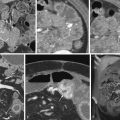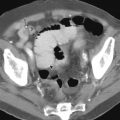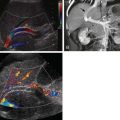Chapter Outline
- Table 36-1.
- Table 36-2.
- Table 36-3.
- Table 36-4.
- Table 36-5.
- Table 36-6.
- Table 36-7.
- Table 36-8.
Dilated Duodenum (Megaduodenum)
- Table 36-9.
TABLE 36-1
Gastric Ulcers (No Mass)
| Cause | Location | Comments |
|---|---|---|
| EROSIONS | ||
| Idiopathic | Antrum or body; often aligned on rugal folds | Varioliform erosions |
| Aspirin or other nonsteroidal anti-inflammatory drugs | Antrum or body; may be on or near greater curvature | Varioliform, linear, or serpiginous erosions |
| Crohn’s disease | Antrum or body | Associated Crohn’s disease in small bowel or colon |
| ULCERS | ||
| Helicobacter pylori | Usually on lesser curvature or posterior wall of antrum or body | Accounts for 70%-80% of gastric ulcers |
| Aspirin or other nonsteroidal anti-inflammatory drugs | Distal half of greater curvature | May simulate malignant ulcer |
| Gastritis | Variable | Hypertrophic gastritis, granulomatous conditions, radiation, caustic ingestion, infections |
| Zollinger-Ellison syndrome | Variable | Associated ulcers in atypical locations; hypergastrinemia |
| Early gastric cancer | Variable | Nodular or deformed folds surrounding ulcer |
TABLE 36-2
Gastric Mass Lesions
| Cause | Radiographic Findings | Comments |
|---|---|---|
| BENIGN MUCOSAL LESIONS | ||
| Hyperplastic polyps | Round sessile polyps in fundus or body; usually multiple | Not premalignant |
| Adenomatous polyps | Lobulated or pedunculated polyps in antrum; often solitary | Premalignant |
| Polyposis syndromes | Multiple polyps in stomach (also in small bowel or colon) | Familial adenomatosis polyposis, Peutz-Jeghers syndrome, Cronkhite-Canada syndrome, juvenile polyposis, Cowden’s disease |
| Villous tumor | Giant mass with soap bubble appearance | Premalignant; rare in stomach |
| Bezoar | Giant masslike filling defect; freely movable | Unusual eating habits; gastroparesis or gastric outlet obstruction |
| MALIGNANT MUCOSAL LESIONS | ||
| Carcinoma | Polypoid mass; ulceration common | Usually advanced gastric cancer but may occasionally be early cancer |
| BENIGN SUBMUCOSAL LESIONS | ||
| Benign gastrointestinal stromal tumor | Smooth submucosal mass; ulceration common; rarely multiple | May be difficult to differentiate from malignant gastrointestinal stromal tumor |
| Leiomyoblastoma | Smooth submucosal mass; ulceration common | Risk of malignancy |
| Lipoma | Submucosal mass with changeable shape at fluoroscopy; fat density on CT | Usually asymptomatic |
| Hemangioma | Submucosal mass with phleboliths | Risk of massive gastrointestinal bleeding |
| Lymphangioma | Submucosal mass | Rare |
| Glomus tumor | Submucosal mass | Usually asymptomatic |
| Neurofibroma | Solitary or multiple submucosal masses | Von Recklinghausen’s disease |
| Granular cell tumor | Solitary or multiple submucosal masses | Associated lesions on skin or tongue |
| Inflammatory fibroid polyp | Sessile or pedunculated polyp in antrum; usually solitary | Usually asymptomatic |
| Ectopic pancreatic rest | Submucosal mass with central umbilication; usually on greater curvature of distal antrum | Usually asymptomatic |
| Duplication cyst | Submucosal mass on greater curvature of antrum or body; rarely communicates with lumen | Usually asymptomatic during first year of life |
| Varices | Multiple submucosal masses in fundus (likened to a bunch of grapes) | Portal hypertension or splenic vein obstruction |
| MALIGNANT SUBMUCOSAL LESIONS | ||
| Malignant gastrointestinal stromal tumor | Solitary, lobulated submucosal mass; ulceration or cavitation common | Better prognosis than carcinoma |
| Metastases | One or more submucosal masses; ulceration or cavitation common; bull’s-eye lesions of varying sizes | Most commonly malignant melanoma or metastatic breast cancer |
| Lymphoma | One or more submucosal masses; ulceration or cavitation common; bull’s-eye lesions of varying sizes | Usually non-Hodgkin’s lymphoma |
| Kaposi’s sarcoma | Multiple submucosal masses or bull’s-eye lesions | Homosexuals with AIDS; usually have Kaposi’s sarcoma on skin |
| Carcinoid | Multiple submucosal masses or bull’s-eye lesions | Carcinoid syndrome uncommon |
| Leukemia | Multiple submucosal masses or polyps | Rare |
| Multiple myeloma | Multiple submucosal masses | Rare |
TABLE 36-3
Thickened Gastric Folds
| Cause | Distribution | Comments |
|---|---|---|
| BENIGN CONDITIONS | ||
| Antral gastritis | Antrum | Epigastric pain or dyspepsia |
| Helicobacter pylori gastritis | Usually antrum or antrum and body; sometimes diffuse | Associated with peptic ulcer disease |
| Hypertrophic gastritis | Fundus and body | Increased acid secretion; frequent duodenal ulcers |
| Ménétrier’s disease | Fundus and body (massive folds) | Hypochlorhydria and hypoproteinemia |
| Zollinger-Ellison syndrome | Fundus and body (increased secretions; ulcers common) | Hypergastrinemia resulting from non-beta islet cell tumors |
| Varices | Fundus and cardia (serpentine folds) | Portal hypertension or splenic vein obstruction |
| Eosinophilic gastritis | Antrum | Peripheral eosinophilia; history of allergic diseases |
| Crohn’s disease | Antrum and body | Associated Crohn’s disease in small bowel or colon |
| Sarcoidosis | Antrum | Pulmonary sarcoidosis |
| Tuberculosis | Antrum | History of AIDS or travel to endemic areas |
| Caustic ingestion | Antrum | History of caustic ingestion |
| Radiation | Antrum | History of radiation therapy (>50 Gy) |
| Floxuridine toxicity | Antrum and body | Hepatic artery infusion chemotherapy |
| Amyloidosis | Antrum | Systemic amyloidosis |
| MALIGNANT CONDITIONS | ||
| Lymphoma | Localized or diffuse | May have generalized lymphoma |
| Carcinoma | Localized or diffuse | Associated narrowing and rigidity of stomach |
Stay updated, free articles. Join our Telegram channel

Full access? Get Clinical Tree








